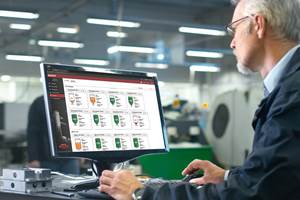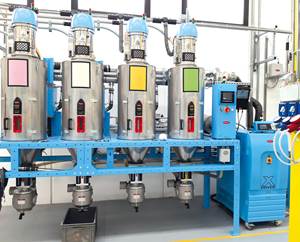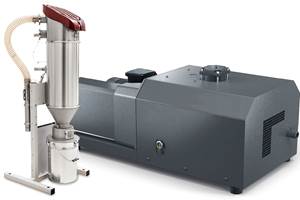Ultrasonic Level Sensor Takes Better Aim at Plastic Materials
Ultrasonic level sensors have had trouble accurately measuring plastic pellets within silos and bins, but new technology can provide more reliable readings and avoid unpleasant surprises.
Ultrasonic level sensors have had trouble accurately measuring plastic pellets within silos and bins, but new technology can provide more reliable readings and avoid unpleasant surprises. That has been the experience of compounder Ampacet Corp., Tarrytown, N.Y.
A few years ago, Ampacet’s Crockett, Texas, plant turned to ultrasonic technology for more reliable level sensing. Ampacet previously had used a mechanical contact method that employed a weighted bob on a cable. The bob dropped until it hit the material. The device would measure the length of cable spooled out. However, material build-up on the cable would prevent it from being wound up to its home position.
Instead of solving the problem, ultrasonic sensors gave inaccurate readings that caused labor and time penalties, says process engineer Leonard Boffa. Each of Ampacet’s six 50,000-lb-capacity silos typically holds between 5000 and 10,000 lb of polyethylene or polypropylene resins or additives for a particular job run. “A main problem was seeing an accurate level when the tank was almost empty,” says Boffa. “We might run out of material when we were right in the middle of a production run.” Alternatively, if excess material remained in the silo after a job was finished, workers would drain it off into containers—a time-consuming measure. These problems created 20 extra hours of labor per month.
Why ultrasonics can fail
The Crockett facility was unable to get reliable ultrasonic level measurements due to process and environmental conditions that lead to false signals. Pellets moving quickly from a railcar to the silo generate friction and heat, which can change the temperature in the tank and thus the speed of the sound signal. Air currents from resin movement in and out of the tank can attenuate the return signal. Noise from loading equipment can compete with the sensor signal.
Problems also stem from ultrasonic technology itself, says James Thornton, service manager at Kistler-Morse, Bothell, Wash., a supplier of ultrasonic level sensors. The narrowness of the ultrasonic beam, as well as the frequency of the beam are especially important when it comes to measuring plastic pellets. “The density and shape of a standard pellet affects the acoustic return signal,” says Thornton. In many cases, the signal from the sensor was absorbed by the pellet, instead of reflected. Or the angularity of the pellet (sharp-cornered or smooth) determined the reflectivity of the material, which in turn affected the strength of the signal.
The beam width of the signal also created problems reading the bottom of the silo, which is typically conical and narrower than the main body of the structure. “Certain ultrasonic sensors use a beam angle that is too wide to target the exit hole at the bottom of the silo. So it couldn’t see pellets at the bottom of the tank,” Thornton explains.
Focus on the beam
To get accurate level readings, Ampacet became a beta site for testing a new ultrasonic sensor from Kistler-Morse that is designed expressly for measuring plastic pellets. This Ultra-Cell level transducer has a narrow beam angle, only five degrees, versus more than 10° for competitive designs. The narrow beam is better able to “see” all the way down into the tapered conical portion at the bottom of the tank. Secondly, the new sensor uses a 24-kHz beam signal, a frequency that Kistler-Morse found to be reflected efficiently by all plastic pellets, Thornton reports.
Boffa says that since Ampacet began testing the Ultra-Cell a year ago, it has received an accurate reading of material in the silo, eliminating the extra labor costs. Ampacet will likely add the technology to all of its raw-material and finished-product silos, says Boffa. Thornton hopes the new design, commercially available for six months, will make ultrasonic technology more than a niche player in measuring resin inventories.
Related Content
Single View of Bin & Silo Material Levels in Multiple Locations
Got a bin in Buffalo and a silo in San José? BinMaster’s latest addition to its cloud inventory software lets you see all your resin inventory anywhere in one view.
Read MoreWisconsin Firms Unite in Battle Against Covid
Teel Plastics opened new plant in record time, partnering with AEC & Aqua Poly Equipment Co. to expand production of swab sticks to fight pandemic.
Read MoreFinding Efficiencies in How Components Work Together
Auxiliary systems are vital to the proper functioning of a plastic processing line, and they can be a source of major cost and efficiency improvements.
Read MoreCentral Controller, Energy-Efficient Pump for Conveying
Wittmann debuts new control system and pump at Fakuma.
Read MoreRead Next
Troubleshooting Screw and Barrel Wear in Extrusion
Extruder screws and barrels will wear over time. If you are seeing a reduction in specific rate and higher discharge temperatures, wear is the likely culprit.
Read MorePeople 4.0 – How to Get Buy-In from Your Staff for Industry 4.0 Systems
Implementing a production monitoring system as the foundation of a ‘smart factory’ is about integrating people with new technology as much as it is about integrating machines and computers. Here are tips from a company that has gone through the process.
Read More









